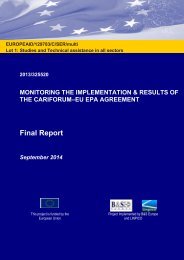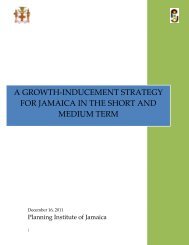Engineers Newsletter
Engineers Newsletter
Engineers Newsletter
Create successful ePaper yourself
Turn your PDF publications into a flip-book with our unique Google optimized e-Paper software.
Less fan-generated noise at reduced<br />
fan speeds. Air distribution<br />
equipment, including fans, ductwork,<br />
and diffusers, can have a significant<br />
impact on background sound levels in<br />
occupied spaces.<br />
Because the fan operates at reduced<br />
speed, a single-zone VAV system<br />
benefits from less fan-generated noise<br />
at part-load conditions. The actual<br />
sound level depends on the type of<br />
fan, operating conditions, and<br />
installation. But, in general, as fan<br />
speed decreases, the sound level will<br />
also decrease.<br />
Application Considerations<br />
In order to realize these benefits, the<br />
specific application must be well-suited<br />
to using single-zone VAV. Following are<br />
some of the challenges or<br />
considerations when applying this type<br />
of system.<br />
Loads throughout a large zone must<br />
be fairly uniform. This is a single-zone<br />
system, responding to a single<br />
temperature sensor, so it does not<br />
have the capability to satisfy<br />
simultaneous heating and cooling<br />
requirements.<br />
If the loads throughout a large zone are<br />
not fairly uniform, it may result in<br />
undesirable temperature variations in<br />
some areas of the zone that are farther<br />
away from the temperature sensor.<br />
30<br />
CV SZVAV<br />
84°F DB, 84°F DB,<br />
76°F DP 76°F DP<br />
(450 cfm) (450 cfm)<br />
74°F DB, 74°F DB,<br />
67% RH 57% RH<br />
MA 77°F DB 79°F DB<br />
Table 1. Part-load dehumidification comparison: CV versus SZVAV<br />
peak DPT<br />
(84°F DBT, 76°F DPT)<br />
constant-speed<br />
fan<br />
Figure 11. Improved dehumidification at part load for an example classroom in<br />
Jacksonville, FL<br />
OA<br />
RA<br />
SA<br />
40<br />
30 40 50 60 70 80 90 100<br />
Design air distribution system to<br />
accommodate variable airflow. Use<br />
diffusers that will provide proper air<br />
distribution at reduced airflows.<br />
Diffusers that are appropriate for<br />
conventional VAV systems are probably<br />
best suited.<br />
Keeping duct runs as short and<br />
symmetric as possible is good general<br />
guidance. Systems with longer or<br />
asymmetric duct runs do not<br />
necessarily prohibit the use of singlezone<br />
VAV, but they are more<br />
susceptible to unequal airflows<br />
between diffusers as the supply fan<br />
modulates.<br />
variable-speed<br />
fan<br />
zone humidity, %RH 67% 57%<br />
cooling load, tons 3.7 4.0<br />
fan airflow, cfm<br />
mild, rainy<br />
(70°F DBT, 69°F WBT)<br />
1500 900<br />
63°F DB 55°F DB<br />
(1500 cfm) (900 cfm)<br />
(3.7 tons) (4.0 tons)<br />
Ensure proper ventilation as supply<br />
airflow changes. For smaller<br />
systems, two-position or proportional<br />
damper control is more likely to be<br />
used, while larger systems may use an<br />
airflow-measurement device, such as a<br />
flow-measuring damper.<br />
When a dedicated outdoor-air system<br />
is used, consider delivering the<br />
conditioned outdoor air directly to each<br />
zone, rather than to the inlet of the<br />
local equipment.<br />
If implementing demand-controlled<br />
ventilation, be sure to provide some<br />
method to vary relief (exhaust) airflow<br />
to prevent negative building pressure<br />
when DCV reduces the intake airflow.<br />
Likewise, if a zone has some type of<br />
minimum exhaust requirement—such<br />
as a restroom, kitchen, or locker<br />
room—DCV should not be allowed to<br />
reduce intake airflow any lower than<br />
the required exhaust, unless the zone<br />
receives makeup air from some other<br />
source.<br />
8 Trane <strong>Engineers</strong> <strong>Newsletter</strong> volume 42-2 providing insights for today’s HVAC system designer<br />
50<br />
SA<br />
60<br />
constant-speed fan<br />
with HGRH<br />
zone humidity, %RH 73% 60% 60%<br />
cooling load, tons 1.6 1.9 2.4<br />
fan airflow, cfm 1500 750 1500<br />
SA<br />
70<br />
RA<br />
MA<br />
80<br />
RA<br />
MA<br />
peak DP<br />
110<br />
180<br />
160<br />
140<br />
120<br />
100<br />
80<br />
60<br />
40<br />
20






